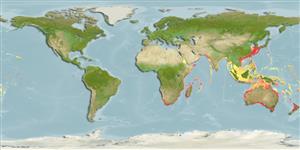Environment: milieu / climate zone / depth range / distribution range
Ecologia
marino; salmastro demersale; distribuzione batimetrica 1 - 200 m (Ref. 4316), usually 75 - 150 m (Ref. 33616). Subtropical; 34°N - 43°S, 15°E - 154°W
Indo-West Pacific: Delagoa Bay, Mozambique to the Cape, South Africa; common in Australia and New Zealand and reported from Japan and Korea. Also reported from Hong Kong (Ref. 12086).
Length at first maturity / Size / Peso / Age
Maturity: Lm 21.2 range ? - ? cm
Max length : 60.0 cm TL maschio/sesso non determinato; (Ref. 4316); common length : 40.0 cm TL maschio/sesso non determinato; (Ref. 9258); peso massimo pubblicato: 1.5 kg (Ref. 9988); Età massima riportata: 15 anni (Ref. 9072)
Short description
Chiavi di identificazione | Morfologia | Morfometria
Spine dorsali (totale) : 9 - 10; Raggi dorsali molli (totale) : 15 - 16; Spine anali: 0; Raggi anali molli: 14 - 16; Vertebre: 33 - 35. Olive or brownish in color, becomes red when stressed; lower half of the inner part of pectoral fin with large black blotch surrounded by numerous pale spots (Ref. 9771).
Found from estuaries to edge of continental shelves over sand and sandy shell seabed (Ref. 9258). Reported to be often found in rivers (Ref. 4316). Juveniles may occur in bays (Ref. 33616). Benthic (Ref. 58302). Dorsal spine reported to be venomous (Ref. 9771). Neither anterolateral glandular grooves nor venom gland is present (Ref. 57406). Current information in the table (dangerous fish) do not match; needs verification. Excellent food fish (Ref. 9771). Utilized fresh and frozen; eaten pan-fried, broiled, microwaved and baked (Ref. 9988).
Life cycle and mating behavior
Maturità | Riproduzione | Deposizione | Uova | Fecundity | Larve
Heemstra, P.C., 1986. Triglidae. p. 486-488. In M.M. Smith and P.C. Heemstra (eds.) Smiths' sea fishes. Springer-Verlag, Berlin. (Ref. 4316)
IUCN Red List Status (Ref. 130435: Version 2024-1)
Human uses
Pesca: commerciale
Strumenti
Special reports
Download XML
Fonti Internet
Estimates based on models
Preferred temperature (Ref.
123201): 13.3 - 25, mean 19.3 °C (based on 186 cells).
Phylogenetic diversity index (Ref.
82804): PD
50 = 0.5010 [Uniqueness, from 0.5 = low to 2.0 = high].
Bayesian length-weight: a=0.00776 (0.00407 - 0.01480), b=3.07 (2.90 - 3.24), in cm total length, based on LWR estimates for this species & (Sub)family-body (Ref.
93245).
Trophic level (Ref.
69278): 3.7 ±0.57 se; based on food items.
Generation time: 2.7 (1.9 - 3.0) years. Estimated as median ln(3)/K based on 10
growth studies.
Resilienza (Ref.
120179): Medio, tempo minimo di raddoppiamento della popolazione 1.4 - 4.4 anni (K=0.4-0.6; tm=2-3; tmax=15;).
Prior r = 0.36, 95% CL = 0.24 - 0.55, Based on 1 data-limited stock assessment.
Fishing Vulnerability (Ref.
59153): Low to moderate vulnerability (29 of 100).
Climate Vulnerability (Ref.
125649): Moderate to high vulnerability (45 of 100).
Nutrients (Ref.
124155): Calcium = 88.2 [46.4, 215.9] mg/100g; Iron = 1.09 [0.59, 2.04] mg/100g; Protein = 19.3 [18.0, 20.7] %; Omega3 = 0.381 [0.173, 1.076] g/100g; Selenium = 41.3 [20.5, 90.6] μg/100g; VitaminA = 7.38 [2.92, 18.85] μg/100g; Zinc = 0.753 [0.531, 1.080] mg/100g (wet weight); based on
nutrient studies.
